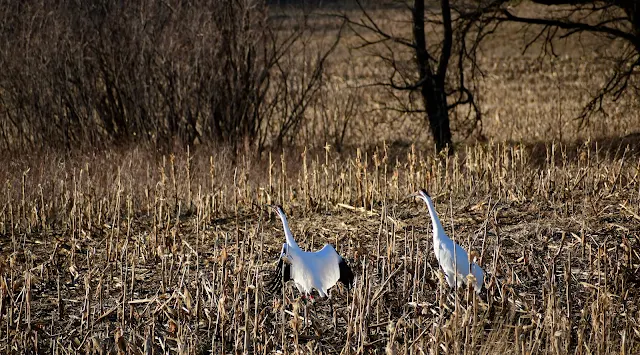Spirit and Cloud. Our Local Whooping Cranes
Spring arrived earlier than usual this year, March 19th, thanks to the leap year. Of course, we are expecting snow this week now. I am still happy and excited that Spring is officially here though! I am ready for the bird migrations to begin! In fact, it has started already. The whooping cranes have come back! We have two local whooping cranes, "Spirit" and "Cloud", who nest on a farm about one mile from our place. Whooping cranes are so beautiful, with an incredible story. Did you know that in 1941 there were only 15 whooping cranes left in the world? They were on the verge of extinction until they were placed on the endangered list. Their numbers grew very slowly over the next 3 decades. During those 3 decades, they increased their numbers on average by about only one bird per year. In the mid-1970s, their total was up to 60. That was better than 15 of course, but probably not sustainable. That is when local legend George Archibald and his friend Ron Suey decided to do something! They established a local research facility called The International Crane Foundation. Here they study cranes from all over the world to help boost populations to keep them around. They also raise baby whooping cranes and then release them in the wild. Recent estimates have put the total number of whooping cranes at over 800. That is a far cry from 15! Approximately 670 live in the wild, while 170 or so live in facilities. I know keeping birds in facilities can seem inhumane, but these facilities help boost the total population. This is needed as much now as it was in 1941. Even though they are not out of danger completely, they are at least on the right track.
Look at that beautiful wingspan!
Think about it, at one time there were only 15 of these birds in existence. They are the rarest of all crane species, with a total of only about 670 in the wild. And you can see them live in their natural habitat one mile from my home! So...... If you come up this way, ask me how you can see these beautiful creatures in their natural habitat. The best viewing time is March through mid-June, while the corn is still low. After the corn gets knee-high by July, you can still see them, but they can also hide better. Having places to hide is important for their "colts" to be able to survive predators. I hope to see you here! And remember, if you are driving in this area and see whooping cranes... PLEASE slow down. We need to protect this amazing bird as much as we possibly can! Thanks!
 |
| Time to eat |
Now Go Out and Hug Someone Today!!!

